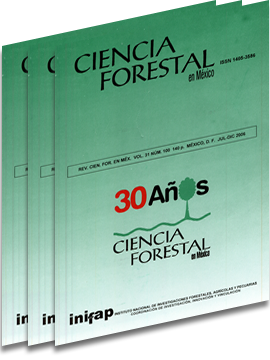LA CORTEZA ARBÓREA COMO BIOMONITOR DEL DEPÓSITO ÁCIDO EN LA CUENCA DE MÉXICO
Palabras clave:
Bioacumulación, biomonitoreo, cedro, depósito ácido, pinoResumen
The atmospheric deposit and the washing of the leaves influence soil chemistry as the K, Ca, Mg and Mn lixiviation modifies its acid condition. Tree bark captures part of this product that is measured through electric conductivity (A), hydrogen potential-(pH) and average buffering capacity (P0); its quantification explains the chemical dynamics and its removal. The total atmospheric acid deposit in Mexico City varíes from a pH of 3.5 to 5.0; during the rainy season, it goes from 5.0 to 5.6, and in the dry months, from 3.0 to 5.6. In 1995 and the dry season of 1996, field work was carried out in the forests of Villa del Carbón, lzta-Popo and Zoquiapan all of which belong to Estado de Mexico, and in the Desierto de Los Leones park, Distrito Federal, in order to monitor the atmospheric deposit present in the tree barks of Pinus montezumae (pine), Cupressus lindleyi (white cedar) and Abies religiosa (Sacred fir). Results showed that the deposited acidity in the pine species varied from 3.15 to 3.6 of pH; from 4.0 to 4.35 in fir trees and from 4.3 to 6.3 in cedar trees. The forests inside the Mexican basin revealed a variation from 2 to 4 pH units; outside of it, the difference was of one unit. lt was concluded that there is acid homogeneity in the forests that belong to the Valle de Mexico basin, but not in Mineral El Chico. Cupressus lindleyi showed the highest buffering capacity and is resistant to the acid effect.
Descargas
Descargas
Publicado
Cómo citar
Número
Sección
Licencia
Los autores que publiquen en la Revista Mexicana de Ciencias Forestales aceptan las siguientes condiciones:
De acuerdo con la legislación de derechos de autor, la Revista Mexicana de Ciencias Forestales reconoce y respeta el derecho moral de los autores, así como la titularidad del derecho patrimonial, el cual será cedido a la revista para su difusión en acceso abierto.
Todos los textos publicados por la Revista Mexicana de Ciencias Forestales –sin excepción– se distribuyen amparados bajo la licenciaCreative Commons 4.0 Atribución-No Comercial (CC BY-NC 4.0 Internacional), que permite a terceros utilizar lo publicado siempre que mencionen la autoría del trabajo y a la primera publicación en esta revista. (no permite el uso comercial)
Los autores pueden realizar otros acuerdos contractuales independientes y adicionales para la distribución no exclusiva de la versión del artículo publicado en la Revista Mexicana de Ciencias Forestales (por ejemplo, incluirlo en un repositorio institucional o darlo a conocer en otros medios en papel o electrónicos) siempre que indique clara y explícitamente que el trabajo se publicó por primera vez en la Revista Mexicana de Ciencias Forestales.
Para todo lo anterior, los autores deben remitir el formato de carta-cesión de la propiedad de los derechos de la primera publicación debidamente requisitado y firmado por los autores/as. Este formato debe ser remitido en archivo PDF al correo: editorial.forestal@inifap.gob.mx
Esta obra está bajo una licencia de Creative Commons Reconocimiento-No Comercial 4.0 Internacional.



